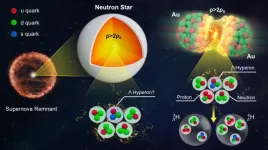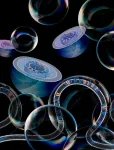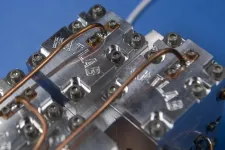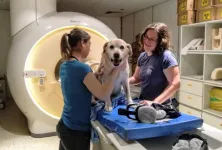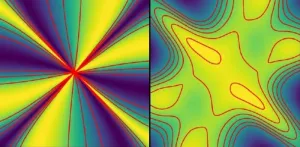(Press-News.org) UPTON, NY—Physicists studying particle collisions at the Relativistic Heavy Ion Collider (RHIC) have published the first observation of directed flow of hypernuclei. These short-lived, rare nuclei contain at least one “hyperon” in addition to ordinary protons and neutrons. Hyperons contain at least one “strange” quark in place of one of the up or down quarks that make up ordinary nucleons (the collective name for protons and neutrons). Such strange matter is thought to be abundant in the hearts of neutron stars, which are among the densest, most exotic objects in the universe. While blasting off to neutron stars to study this exotic matter is still the stuff of science fiction, particle collisions could give scientists insight into these celestial objects from a laboratory right here on Earth.
“The conditions in a neutron star may still be far from what we reach at this moment in the laboratory, but at this stage it’s the closest we can get,” said Xin Dong, a physicist from the U.S. Department of Energy’s Lawrence Berkeley National Laboratory (LBNL) who was involved in the study. “By comparing our data from this laboratory environment to our theories, we can try to infer what happens in the neutron star.”
The scientists used the STAR detector at RHIC, a DOE Office of Science user facility for nuclear physics research at Brookhaven National Laboratory, to study the flow patterns of the debris emitted from collisions of gold nuclei. Those patterns are triggered by the enormous pressure gradients generated in the collisions. By comparing the flow of hypernuclei with that of similar ordinary nuclei made only of nucleons, they hoped to gain insight into interactions between the hyperons and nucleons.
“In our normal world, nucleon-nucleon interactions form normal atomic nuclei. But when we move into a neutron star, hyperon-nucleon interactions—which we don’t know much about yet—become very relevant to understanding the structure,” said Yapeng Zhang, another member of STAR from the Institute of Modern Physics of the Chinese Academy of Sciences, who led the data analysis together with his student Chenlu Hu. Tracking how hypernuclei flow should give the scientists insight into the hyperon-nucleon interactions that form these exotic particles.
The data, just published in Physical Review Letters, will provide quantitative information theorists can use to refine their descriptions of the hyperon-nucleon interactions that drive the formation of hypernuclei—and the large-scale structure of neutron stars.
“There are no solid calculations to really establish these hyperon-nucleon interactions,” said Zhang. “This measurement may potentially constrain theories and provide a variable input for the calculations.”
Go with the flow
Previous experiments have shown that the flow patterns of regular nuclei generally scale with mass—meaning the more protons and neutrons a nucleus has, the more the nuclei exhibit collective flow in a particular direction. This indicates that these nuclei inherit their flow from their constituent protons and neutrons, which coalesce, or come together, because of their interactions, which are governed by the strong nuclear force.
The STAR results reported in this paper show that hypernuclei follow this same mass-scaling pattern. That means hypernuclei most likely form via the same mechanism.
enlarge
A side view of the Solenoidal Tracker at RHIC (STAR) experiment at the Relativistic Heavy Ion Collider (RHIC), a particle collider for nuclear physics research at the U.S. Department of Energy's Brookhaven National Laboratory.
“In the coalescence mechanism, the nuclei (and hypernuclei) form this way depending on how strong the interactions are between the individual components,” Dong said. “This mechanism gives us information about the interaction between the nucleons (in nuclei) and nucleons and hyperons in hypernuclei.”
Seeing similar flow patterns and the mass scaling relationship for both normal nuclei and hypernuclei, the scientists say, implies that the nucleon-nucleon and hyperon-nucleon interactions are very similar.
The flow patterns also convey information about the matter generated in the particle smashups—including how hot and dense it is and other properties.
“The pressure gradient created in the collision will induce some asymmetry in the outgoing particle direction. So, what we observe, the flow, reflects how the pressure gradient is created inside the nuclear matter,” Zhang said.
“The measured flow of hypernuclei may open a new door to study hyperon-nucleon interactions under finite pressure at high baryon density.”
The scientists will use additional measurements of how hypernuclei interact with that medium to learn more about its properties.
The benefits of low energy
This research would not have been possible without the versatility of RHIC to operate over such a wide range of collision energies. The measurements were made during Phase I of the RHIC Beam Energy Scan—a systematic study of gold-gold collisions ranging from 200 GeV per colliding particle pair down to 3 GeV.
To reach that lowest energy, RHIC operated in “fixed-target” mode: One beam of gold ions traveling around the 2.4-mile-circumference RHIC collider crashed into a foil made of gold placed inside the STAR detector. That low energy gives scientists access to the highest “baryon density,” a measure related to the pressure generated in the collisions.
“At this lowest collision energy, where the matter created in the collision is very dense, nuclei and hypernuclei are produced more abundantly than at higher collision energies,” said Yue-Hang Leung, a postdoctoral fellow from the University of Heidelberg, Germany. “The low-energy collisions are the only ones that produce enough of these particles to give us the statistics we need to do the analysis. Nobody else has ever done this before.”
How does what the scientists learned at RHIC relate to neutron stars?
The fact that hypernuclei appear to form via coalescence just like ordinary nuclei implies that they, like those ordinary nuclei, are created at a late stage of evolution of the collision system.
“At this late stage, the density for the hyperon-nucleon interaction we see is not that high,” Dong said. “So, these experiments may not be directly simulating the environment of a neutron star.”
But, he added, “This data is fresh. We need our theory friends to weigh in. And they need to include this new data on hyperon-nucleon interactions when they build a new neutron star model. We need both experimentalists and our theorists’ efforts to work towards understanding this data and making those connections.”
This research was funded by the DOE Office of Science (NP), the U.S. National Science Foundation, and a range of international organizations and agencies listed in the scientific paper. The STAR team used computing resources at the Scientific Data and Computing Center at Brookhaven Lab, the National Energy Research Scientific Computing Center (NERSC) at DOE’s Lawrence Berkeley National Laboratory, and the Open Science Grid consortium.
Brookhaven National Laboratory is supported by the Office of Science of the U.S. Department of Energy. The Office of Science is the single largest supporter of basic research in the physical sciences in the United States and is working to address some of the most pressing challenges of our time. For more information, visit science.energy.gov.
Follow @BrookhavenLab on Twitter or find us on Facebook.
Related Links
Scientific paper: "First Observation of Directed Flow of Hypernuclei 3ΛH and 4ΛH in √sNN = 3 GeV Au+Au Collisions at RHIC" END
First measurements of hypernuclei flow at RHIC
Particle collisions offer new way to study interactions of hyperon particles with ordinary nuclear building blocks, potentially giving insight into the properties of neutron stars
2023-05-26
ELSE PRESS RELEASES FROM THIS DATE:
When the cell digests itself: How inherited neurodegenerative diseases develop
2023-05-26
FRANKFURT. A tangle of pockets, tubes and sac-like membrane structures runs through the cells of humans, animals, plants and fungi: the endoplasmic reticulum, or ER for short. In the ER, proteins are manufactured, folded into their three-dimensional structure and modified, lipids and hormones are produced and calcium concentrations in the cell are controlled. In addition, the ER forms the basis for the cellular transport system, feeds misfolded proteins to intracellular disposal and renders toxins that have entered the cell harmless.
In ...
Army funds two quantum-related projects at Pitt
2023-05-26
The U.S. Army has awarded more than $5.7 million for two projects led by Michael Hatridge, associate professor of physics and astronomy in the Kenneth P. Dietrich School of Arts and Sciences. Both projects bring together a diverse group of researchers to overcome roadblocks in the field of quantum computing.
A four-year, $2.67 million grant is aimed at the next generation of modular quantum computing systems. Hatridge and co-principal investigators Robert Schoelkopf of Yale University have each developed unique ...
Emergence of solvated dielectrons observed for the first time
2023-05-26
Solvated dielectrons are the subject of many hypotheses among scientists, but have never been directly observed. They are described as a pair of electrons that is dissolved in liquids such as water or liquid ammonia. To make space for the electrons a cavity forms in the liquid, which the two electrons occupy. An international research team around Dr. Sebastian Hartweg, initially at Synchrotron SOLEIL (France), now at the Institute of Physics at the University of Freiburg and Prof. Dr. Ruth Signorell from ETH Zurich, including scientists ...
Networks in the dog brain
2023-05-26
A study on canine brain networks reveals that during mammalian brain evolution, the role of the cingulate cortex, a bilateral structure located deep in the cerebral cortex, was partly taken over by the lateral frontal lobes, which control problem-solving, task-switching, and goal-directed behavior. The study relies on a new canine resting state fMRI brain atlas, which can aid in the analysis of diseases characterized by dysfunctional integration and communication among brain areas.
Researchers interested in how dogs think can not only deduce it from their behavior, but they can also investigate their brain activity using fMRI (functional ...
Fractons as information storage: Not yet quite tangible, but close
2023-05-26
Excitations in solids can also be represented mathematically as quasiparticles; for example, lattice vibrations that increase with temperature can be well described as phonons. Mathematically, also quasiparticles can be described that have never been observed in a material before. If such "theoretical" quasiparticles have interesting talents, then it is worth taking a closer look. Take fractons, for example.
Perfect storage of information
Fractons are fractions of spin excitations and are not allowed to possess kinetic energy. As a consequence, they are completely stationary and immobile. This makes fractons new candidates for perfectly secure information storage. Especially since ...
Defence lawyers face challenges accessing and reviewing digital evidence, study shows
2023-05-26
Defence lawyers face numerous challenges accessing and reviewing evidence from phones and computers, a new study shows.
Solicitors and barristers have reported their use of digital evidence can be restricted by limited or late access, large volumes of material, and tight turnaround times to secure legal aid funding and choose and instruct independent experts.
The research calls for more clarity and transparency around the collection and analysis of digital evidence and the streamlining of the format and presentation of information.
The current volume and diversity of digital evidence available escalates tensions, delays access to digital ...
Barren habitat for sows leaves imprint on piglets’ brains
2023-05-26
In a new study, researchers from Uppsala University in Sweden, together with colleagues from the University of São Paulo, Brazil, have investigated the impact that a barren living environment for sows leaves on the next generation. The pigs in the study were bred in Brazil and kept according to breeding standards in that country. The sows’ uncomfortable and unstimulating environment brought with it several different types of changes in the epigenome of their offspring.
In many parts of the world, sows are kept confined in concrete stalls while they are pregnant. This is a bad environment for the pigs, both in terms ...
Quantum sensor for a future navigation system tested aboard Royal Navy ship
2023-05-26
A prototype quantum sensor with potential applications in GPS-free navigation, developed at Imperial College London, has been tested in collaboration with the Royal Navy.
The test marks an important step in bringing new quantum technologies out of the lab and into real-world settings.
Many navigation systems today rely on global navigation satellite systems (GNSS), such as GPS, which uses signals from satellites orbiting the Earth. However, GPS navigation is not always accessible, obstacles like tall buildings can easily block the satellite signals, and they are also susceptible ...
Hydrogen sulfide in cancer treatment
2023-05-26
Hydrogen sulfide is usually a highly toxic gas. However, with careful preparation, it can be used to support photothermal therapy (PTT) in treating cancer, as a team of researchers reporting in the journal Angewandte Chemie has recently discovered. As the team reports, an adjuvant releasing hydrogen sulfide causes tumor cells to lose their natural heat protection and thus to become significantly more sensitive to PTT.
Breathing in gaseous hydrogen sulfide usually causes us to suffocate, because the gas suppresses the respiratory chain in the mitochondria, ...
First death in the UK associated with Xylazine
2023-05-26
The death of a 43-year-old male is the first in the UK to be associated with Xylazine and marks the entry of the drug into the UK drug supply.
New research published in the Journal of Forensic and Legal Medicine from King’s College London details the death of the man in May 2022 from the effects of Xylazine alongside heroin, fentanyl and cocaine.
Xylazine is a non-opioid sedative, painkiller and muscle relaxant used in veterinary medicine as a tranquiliser for large animals. The drug – known ...
LAST 30 PRESS RELEASES:
Like alcohol units, but for cannabis – experts define safer limits
DNA testing of colorectal polyps improves insight into hereditary risks
Researchers uncover axonal protein synthesis defect in ALS
Why are men more likely to develop multiple myeloma than women?
Smartphone-based interventions show promise for reducing alcohol and cannabis use: New research
How do health care professionals determine eligibility for MAiD?
Microplastics detected in rural woodland
JULAC and Taylor & Francis sign open access agreement to boost the impact of Hong Kong research
Protecting older male athletes’ heart health
KAIST proposes AI-driven strategy to solve long-standing mystery of gene function
Eye for trouble: Automated counting for chromosome issues under the microscope
The vast majority of US rivers lack any protections from human activities, new research finds
Ultrasound-responsive in situ antigen "nanocatchers" open a new paradigm for personalized tumor immunotherapy
Environmental “superbugs” in our rivers and soils: new one health review warns of growing antimicrobial resistance crisis
Triple threat in greenhouse farming: how heavy metals, microplastics, and antibiotic resistance genes unite to challenge sustainable food production
Earthworms turn manure into a powerful tool against antibiotic resistance
AI turns water into an early warning network for hidden biological pollutants
Hidden hotspots on “green” plastics: biodegradable and conventional plastics shape very different antibiotic resistance risks in river microbiomes
Engineered biochar enzyme system clears toxic phenolic acids and restores pepper seed germination in continuous cropping soils
Retail therapy fail? Online shopping linked to stress, says study
How well-meaning allies can increase stress for marginalized people
Commercially viable biomanufacturing: designer yeast turns sugar into lucrative chemical 3-HP
Control valve discovered in gut’s plumbing system
George Mason University leads phase 2 clinical trial for pill to help maintain weight loss after GLP-1s
Hop to it: research from Shedd Aquarium tracks conch movement to set new conservation guidance
Weight loss drugs and bariatric surgery improve the body’s fat ‘balance:’ study
The Age of Fishes began with mass death
TB harnesses part of immune defense system to cause infection
Important new source of oxidation in the atmosphere found
A tug-of-war explains a decades-old question about how bacteria swim
[Press-News.org] First measurements of hypernuclei flow at RHICParticle collisions offer new way to study interactions of hyperon particles with ordinary nuclear building blocks, potentially giving insight into the properties of neutron stars
